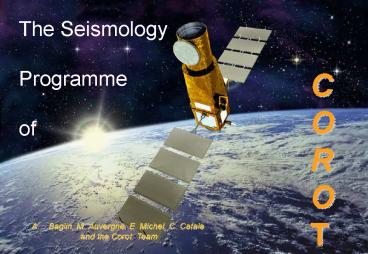intro - PowerPoint PPT Presentation
1 / 12
Title: intro
1
intro
The Seismology Programme of
C O R O T
- Baglin, M. Auvergne, E. Michel, C. Catala
- and the Corot Team
2
The mission
Launch date early 2006
camera
Launcher to be chosen between
Low earth polar orbit 827 km
Baffle
Off axis telescope
Proteus platform Star trackers
Equipement bay
3
Participants
Brazil
Austria
Belgium
Spain
RSSD/ESTEC/ESA
ESA, Sc prog.
Germany
4
Field of view and observable regions of the sky
Core programme (CO-Is) 5 long runs (150
days, 0.1mHz) 50 stars 5 short runs (20 to 30
days, 0.5mHz) 50 stars Additional programmes
(open AO selection)
5
Photometric performances in the seismology field
Aperture photometry on highly out of focus
images 50 pixels (1px 2.32 arcsec)
For mv5.7 in five days photon noise Np
0.6ppm total noise Nt 0.61ppm Nt 0.61
10 0.2(mv-5.7) for mvlt9 For mv gt 9 increase
of the readout noise Very low jitter and
background noises
Photon noise and total white noise as a function
of magnitude in ppm for a five days observation
6
Low frequency perturbators
Main contributions due to the orbital
motion Temperature variations RQ CCD,
Electronic gain Attitude fluctuations Time
scales Porb, Porb/2, Porb/3, Porb/4 Estimated
amplitude Porb 20 ppm, Porb/2 12
ppm Highly coherent
MS Delta Scuti
Procyon
Perturbed frequency domain, superimposed on the
frequency spectrum of typical targets
The efficiency of the corrections are yet not
known precisely, depending on the HK measurements
and calibrations precision
7
The long runs Main targets
Preliminary selection solar like stars,
delta Scuti, beta Ceph (not yet chosen)
Position of the preselected targets in the HR
diagram
8
The population of secondary targets
Example of a set of secondary targets, chosen in
the field of the main targets Preference given
to Parallax high (always gt 4 mas) Main
sequence and subgiants -0.2 lt (B-V) lt 0.8
Mv
Preliminary Mv/(B-V) diagram Data from
Tycho Illustrating the possibillity to map most
of the HR diagram
B-V
Presently, uncertainties are very large! Work is
in progress to derive more precise fundamental
parameters
9
Furbishing tools for seismic interpertations
Estimating the potential interest of specific
candidate stars e.g. tackling the base of the
converctive zone and HeII ionisation zone in the
variations of the second order difference dn ,
here for a 1.2Mo candidate target.
Data analysis of synthetic representative 150d
light-curves Recovering originally unknown input
frequencies
T. Appourchaux, C. Barban
Difference input frequencies- recovered ones
A. Mazumdar
Intricate spectrum expected for HD 57006
G. Berthomieu, T. Toutain
Estimating the potential difficulties for
specific candidate stars e.g. dealing with very
dense oscillation spectra of evolved Stars.
10
The ground based observations
Collection of data on potential targets to
determine the fundamental parameters (Teff,
logg, Fe/H, Vsini..) select the
targets prepare ground-based support and
follow-up
Bright stars for the seismology field 250
nights 0.9 to 3.5 m telescopes 1500
stars Observations completed Reductions
done at 85 Data base GAUDI at
LAEFF
Faint stars for the exoplanet field 20 nights
2.5m telescopes 100 million stars
Observations done at 40 Reduction done at
20 Data base EXODAT at LAM
Effort supported by Laboratories and
Participating Countries
11
Performances in the exoplanet field
Three colors aperture photometry on dispersed
images time sampling 32s
Note Blue (resp. red) is defined as 308 (resp.
40 15) of the total flux And then do not
correspond to a fixed photometric system
The jitter is the major source of instrumental
noise It will be corrected on ground, reducing
the noise by a factor at least 10
12
Seismology as Additional Programmes
Data collected for the exoplanet search, mvlt 16,
6000 stars per CCD Specific targets (100 per
CCD) A few specific short runs
Access through an AO (to be issued next
year) open to all members of contributing
countries































